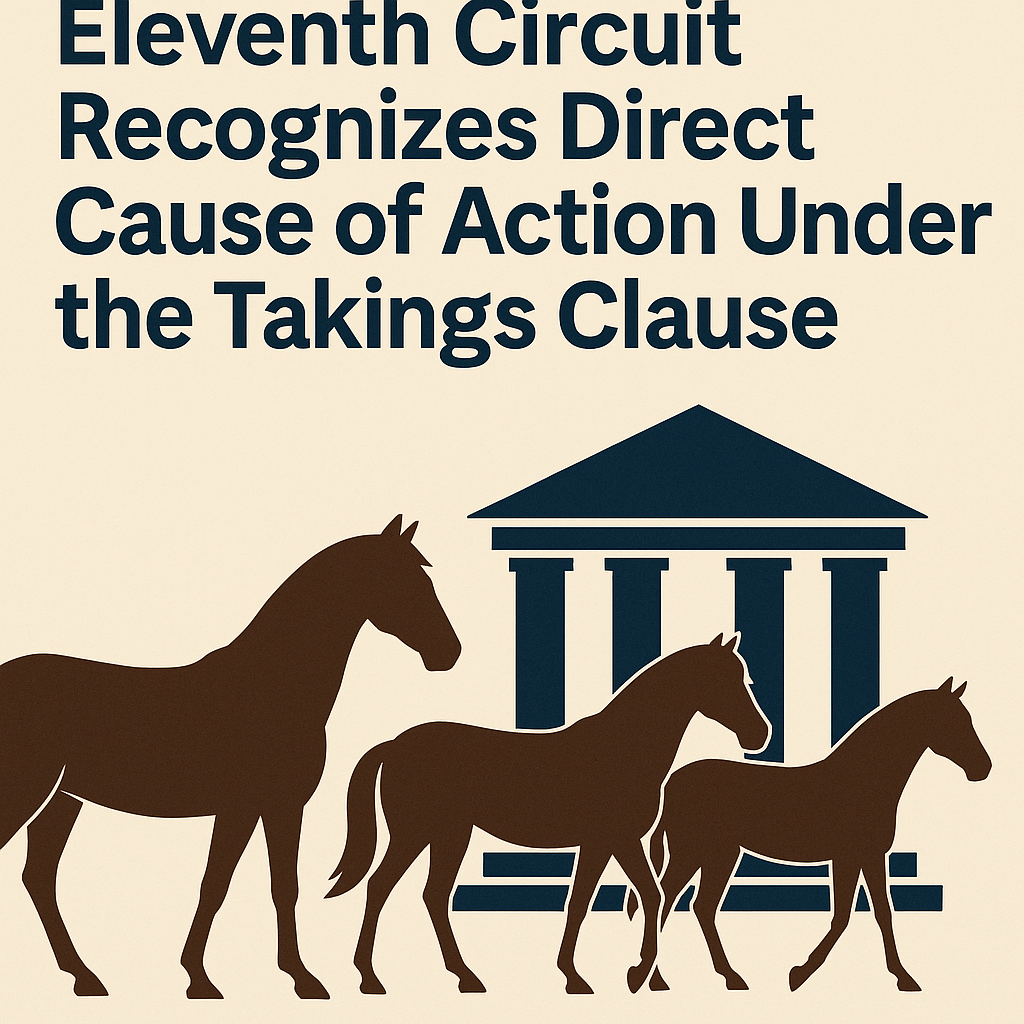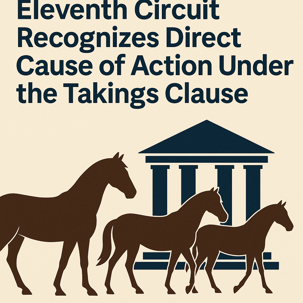 Eleventh Circuit Recognizes Direct Cause of Action Under the Takings Clause
Eleventh Circuit Recognizes Direct Cause of Action Under the Takings Clause
In a landmark decision issued on July 31, 2025, the Eleventh Circuit Court of Appeals held that the Fifth Amendment’s Takings Clause provides a direct cause of action against local governments—even when no statute like 42 U.S.C. § 1983 applies. This ruling in Fulton v. Fulton County Board of Commissioners marks a significant development in constitutional law and property rights.
The Case in Brief: Fulton’s Fight for Compensation
Brandon Fulton was arrested in 2017 on felony animal cruelty charges, and seven of his horses were seized by Fulton County Animal Services. Although the charges were dropped a year later, his horses were never returned. Fulton sued in 2020, initially invoking § 1983 to claim a violation of his Fifth Amendment rights. However, because he couldn’t show the seizure occurred under an official municipal “policy or custom”—as required by Monell v. Department of Social Services—his claim was dismissed.
When Fulton sought to amend his complaint to assert a claim directly under the Takings Clause of the Constitution, the district court said no, reasoning that no such standalone constitutional claim exists. Fulton appealed.
The Eleventh Circuit’s Holding: A “Self-Executing” Right Means a Direct Cause of Action
Writing for the majority, Judge Rosenbaum engaged in a deep textual and historical analysis. Drawing on the language of the Fifth and Fourteenth Amendments, the Court concluded that the Takings Clause is “self-executing,” meaning its promise of “just compensation” is not dependent on congressional authorization.
The Court rejected the idea that Congress must affirmatively create a remedy for constitutional rights that, by their nature, promise a specific remedy—particularly “just compensation” and the writ of habeas corpus. It emphasized that to treat the Takings Clause otherwise would be to render its promise illusory:
“The Takings Clause guarantees a legal damages-type remedy, and it is ‘self-executing.’ These characteristics... make the Takings Clause a constitutional unicorn—no other constitutional guarantee expressly contains these two features.”
Why the Decision Matters: More Than Just Horses
This case is about more than one man’s loss of his horses. The opinion carves out new legal territory with wide-reaching implications:
Direct Claims Without § 1983: Plaintiffs whose property is taken by local governments can now sue directly under the Constitution, even if they cannot meet the Monell “policy or custom” standard required under § 1983.
Circumventing Procedural Bars: The Court also found that Georgia’s procedural rules, including a 12-month notice requirement for claims against counties, could not bar a constitutional claim for compensation.
Clarifying Jurisdiction and Remedy: The decision explains that federal-question jurisdiction under 28 U.S.C. § 1331 supports such direct claims and that the Constitution itself supplies both the right and the remedy.
Looking Forward
The opinion answers a question the Supreme Court recently sidestepped in DeVillier v. Texas, 601 U.S. 285 (2024): Does the Takings Clause create a cause of action? The Eleventh Circuit now says yes.
Expect future litigation to explore the boundaries of this ruling:
How will district courts apply this ruling when qualified immunity is asserted by government actors?
Will other circuits adopt or reject the Eleventh Circuit’s approach?
Could this ruling prompt further Supreme Court review?
Conclusion
The Eleventh Circuit’s recognition of a direct cause of action under the Takings Clause restores the Constitution’s promise that “no private property [shall] be taken for public use, without just compensation.” Property owners who have long faced procedural barriers now have a clearer path to vindicating their rights in federal court—even without statutory support.

